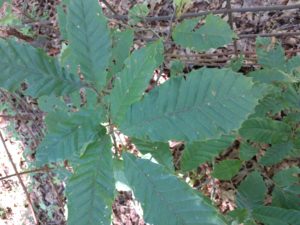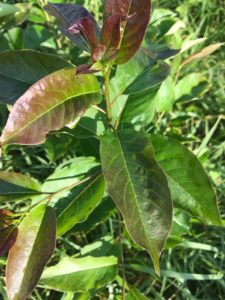Where Can You Find Chestnut Trees?
go.ncsu.edu/readext?611092
en Español / em Português
El inglés es el idioma de control de esta página. En la medida en que haya algún conflicto entre la traducción al inglés y la traducción, el inglés prevalece.
Al hacer clic en el enlace de traducción se activa un servicio de traducción gratuito para convertir la página al español. Al igual que con cualquier traducción por Internet, la conversión no es sensible al contexto y puede que no traduzca el texto en su significado original. NC State Extension no garantiza la exactitud del texto traducido. Por favor, tenga en cuenta que algunas aplicaciones y/o servicios pueden no funcionar como se espera cuando se traducen.
Português
Inglês é o idioma de controle desta página. Na medida que haja algum conflito entre o texto original em Inglês e a tradução, o Inglês prevalece.
Ao clicar no link de tradução, um serviço gratuito de tradução será ativado para converter a página para o Português. Como em qualquer tradução pela internet, a conversão não é sensivel ao contexto e pode não ocorrer a tradução para o significado orginal. O serviço de Extensão da Carolina do Norte (NC State Extension) não garante a exatidão do texto traduzido. Por favor, observe que algumas funções ou serviços podem não funcionar como esperado após a tradução.
English
English is the controlling language of this page. To the extent there is any conflict between the English text and the translation, English controls.
Clicking on the translation link activates a free translation service to convert the page to Spanish. As with any Internet translation, the conversion is not context-sensitive and may not translate the text to its original meaning. NC State Extension does not guarantee the accuracy of the translated text. Please note that some applications and/or services may not function as expected when translated.
Collapse ▲This week I want to share three questions we received at the Caldwell Extension Center. I hope you find these questions and their answers helpful.
Question: I was hoping to find any information regarding chestnut tree planting in western North Carolina, including current farms. I’m looking to acquire an existing farm or to find a suitable property and begin a chestnut tree orchard.
Answer: This was a stumper question for me, so I reached out to my colleagues in western NC. Rob Hawk in Jackson & Swain County told me about Cataloochee Ranch in Maggie Valley. They have an orchard, and they provide tours. Call (828.926.1401) to set up a tour. This is being done in conjunction with the American Chestnut Foundation.
The NC Forest Service has a trial of Phytophthora resistant, as well as chestnut blight resistant, seedlings at their nursery in Crossnore. This, of course, isn’t something anyone could purchase, but I assume this place could be visited.
I also know there are a few American Chestnuts from the American Chestnut Foundation’s breeding program planted in Caldwell County. These trees are resistant to the chestnut blight. The largest of these plantings is at Patterson School in Happy Valley. I believe they have six or eight trees.

Chestnut trees once dominated the forests until the chestnut blight arrived in 1904. By the early 1940’s, all the mature chestnut trees were dead from the blight. The American Chestnut Foundation has been working to breed American Chestnut trees that are resistant to the blight. Pictured is a three year old blight resistant American Chestnut growing in Caldwell County. Maybe one day these mighty trees will dominate the forests again.
Question: My neighbor has chickens, turkeys, and dairy calves. They often run free around the neighborhood, including the adjacent church property. What can be done?
Answer: In this case, North Carolina General Statutes Chapter 68 entitled “Fences and Stock Law” covers this situation. This is a very short chapter of only a page or so, but the important sections for this question are below. I’ve abridged the important parts of the law to keep this concise, but I encourage reading the entire chapter and to seek legal assistance to interpret the law in your particular situation.
- 68-16 – Allowing livestock to run at large forbidden. If any person shall allow his livestock to run at large, he shall be guilty of a Class 3 misdemeanor.
- 68-17. Impounding livestock at large; right to recover costs and damages; abandoned livestock.
(a) Any person may take up any livestock running at large or straying and impound the same; and such impounder may recover from the owner the reasonable costs of impounding and maintaining the livestock as well as damages to the impounder caused by such livestock, and may retain the livestock, with the right to use with proper care until such recovery is had. Reasonable costs of impounding shall include any fees paid pursuant to G.S. 68-18.1 in order to locate the owner.
- 68-19. Determination of damages by selected landowners or by referee. If the owner and impounder cannot agree as to the cost of impounding and maintaining such livestock, as well as damages to the impounder caused by such livestock running at large, then such costs and damages shall be determined by three disinterested landowners, one to be selected by the owner of the livestock, one to be selected by the impounder, and a third to be selected by the first two. If within 10 days a majority of the landowners so selected cannot agree, or if the owner of the livestock or the impounder fails to make his selection, or if the two selected fail to select a third, then the clerk of superior court of the county where the livestock is impounded shall select a referee. The determination of such costs and damages by the landowners or by the referee shall be final.
- 68-25. Domestic fowls running at large after notice.
(a) If any person shall permit any turkeys, geese, chickens, ducks, or other domestic fowls to run at large on the lands of any other person while such lands are under cultivation in any kind of grain or feedstuff or while being used for gardens or ornamental purposes, after having received actual or constructive notice of such running at large, the person is guilty of a Class 3 misdemeanor.
(c) If it shall appear to any magistrate that after three days’ notice any person persists in allowing his fowls to run at large in violation of this section and fails or refuses to keep them upon his own premises, then the said magistrate may, in his discretion, order any sheriff or other officer to kill the fowls when they are running at large as herein provided.
Question: Found this in a hay field. Any thoughts what it is? (See image)

This is one of many sourwood seedlings that are starting to populate a hay field. These trees will not be able to survive if the field is regularly harvested for hay. Sourwood seedlings can be transplanted, but larger trees will not survive if moved.
Answer: This is a sourwood tree seedling. Sourwood is a native tree species. I think of it as a pioneer species. It has been one of the many tree species suggested by the USDA – Forest Service to be planted when reclaiming areas that were previously mined or otherwise had the top soil removed.
Sourwood prefers slightly acidic soil. I suggest testing the soil since this is a hayfield. These trees might be an indication there are soil fertility issues.
The scientific name for sourwood (Oxydendrum arboreum) comes from the Greek words oxys (acid) and dendron (tree) and refers to the sour taste of its leaves. The leaves are used as a thirst-quencher by hikers and mountain climbers and were once brewed to make a tonic.
The largest known sourwood in North America is in Robbinsville, N.C. It is 118 feet tall with a 2-foot trunk.
If you have agricultural questions, contact the Caldwell Extension Center at 828-757-1290, or email me at seth_nagy@ncsu.edu.




